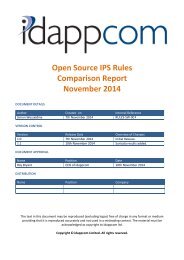The use of the Internet
The use of the Internet
The use of the Internet
You also want an ePaper? Increase the reach of your titles
YUMPU automatically turns print PDFs into web optimized ePapers that Google loves.
4<br />
THE USE OF THE INTERNET FOR TERRORIST PURPOSES<br />
basic tenets <strong>of</strong> international law is <strong>the</strong> protection <strong>of</strong> fundamental human rights, which<br />
include <strong>the</strong> right to freedom <strong>of</strong> expression (see discussion in section I.D below). This<br />
guarantees an individual <strong>the</strong> right to share an opinion or distribute content which may<br />
be considered objectionable by o<strong>the</strong>rs, subject to certain limited exceptions. One commonly<br />
accepted exclusion with respect to that right is <strong>the</strong> prohibition against <strong>the</strong> distribution<br />
<strong>of</strong> certain categories <strong>of</strong> sexually explicit content, <strong>the</strong> prohibition <strong>of</strong> which is<br />
deemed to be in <strong>the</strong> public interest in order to protect certain vulnerable groups. O<strong>the</strong>r<br />
exclusions, all <strong>of</strong> which must be provided for by law and shown to be necessary, may<br />
include communications that are clearly detrimental to <strong>the</strong> protection <strong>of</strong> national security<br />
and communications that are both intended and likely to incite acts <strong>of</strong> violence against<br />
individuals or specific groups <strong>of</strong> individuals. 3<br />
4. <strong>The</strong> promotion <strong>of</strong> violence is a common <strong>the</strong>me in terrorism-related propaganda.<br />
<strong>The</strong> broad reach <strong>of</strong> content distributed via <strong>the</strong> <strong>Internet</strong> exponentially increases <strong>the</strong><br />
audience that may be affected. Fur<strong>the</strong>r, <strong>the</strong> ability to directly distribute content via <strong>the</strong><br />
<strong>Internet</strong> diminishes <strong>the</strong> reliance on traditional channels <strong>of</strong> communication, such as news<br />
services, which may take steps to independently evaluate <strong>the</strong> credibility <strong>of</strong> <strong>the</strong> information<br />
provided or to edit or omit aspects deemed to be unduly provocative. <strong>Internet</strong><br />
propaganda may also include content such as video footage <strong>of</strong> violent acts <strong>of</strong> terrorism<br />
or video games developed by terrorist organizations that simulate acts <strong>of</strong> terrorism and<br />
encourage <strong>the</strong> <strong>use</strong>r to engage in role-play, by acting <strong>the</strong> part <strong>of</strong> a virtual terrorist.<br />
5. <strong>The</strong> promotion <strong>of</strong> extremist rhetoric encouraging violent acts is also a common<br />
trend across <strong>the</strong> growing range <strong>of</strong> <strong>Internet</strong>-based platforms that host <strong>use</strong>r-generated<br />
content. Content that might formerly have been distributed to a relatively limited audience,<br />
in person or via physical media such as compact discs (CDs) and digital video<br />
discs (DVDs), has increasingly migrated to <strong>the</strong> <strong>Internet</strong>. Such content may be distributed<br />
using a broad range <strong>of</strong> tools, such as dedicated websites, targeted virtual chat<br />
rooms and forums, online magazines, social networking platforms such as Twitter and<br />
Facebook, and popular video and file-sharing websites, such as YouTube and Rapidshare,<br />
respectively. <strong>The</strong> <strong>use</strong> <strong>of</strong> indexing services such as <strong>Internet</strong> search engines also makes it<br />
easier to identify and retrieve terrorism-related content.<br />
6. <strong>The</strong> fundamental threat posed by terrorist propaganda relates to <strong>the</strong> manner in<br />
which it is <strong>use</strong>d and <strong>the</strong> intent with which it is disseminated. Terrorist propaganda distributed<br />
via <strong>the</strong> <strong>Internet</strong> covers a range <strong>of</strong> objectives and audiences. It may be tailored,<br />
inter alia, to potential or actual supporters or opponents <strong>of</strong> an organization or shared<br />
extremist belief, to direct or indirect victims <strong>of</strong> acts <strong>of</strong> terrorism or to <strong>the</strong> international<br />
community or a subset <strong>the</strong>re<strong>of</strong>. Propaganda aimed at potential or actual supporters may<br />
be foc<strong>use</strong>d on recruitment, radicalization and incitement to terrorism, through messages<br />
conveying pride, accomplishment and dedication to an extremist goal. It may also be<br />
<strong>use</strong>d to demonstrate <strong>the</strong> effective execution <strong>of</strong> terrorist attacks to those who have provided<br />
financial support. O<strong>the</strong>r objectives <strong>of</strong> terrorist propaganda may include <strong>the</strong> <strong>use</strong> <strong>of</strong><br />
psychological manipulation to undermine an individual’s belief in certain collective social<br />
3 Ibid., art. 19, para. 3.







